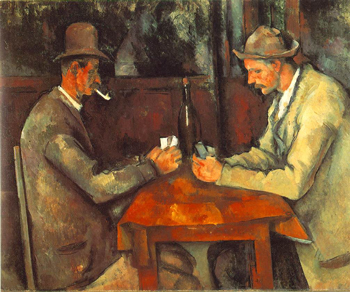| Search Art Prints | ||||||||||||||||||||
| Search Artists | ||||||||||||||||||||

|
||||||||||||||||||||
|
|
|||||||||||||||||||

The Card Players

|
The Cardplayers is one of Cézanne's most famous and celebrated works. Cézanne produced a series of paintings (including many preparatory studies) of men playing cards, mostly people who lived near, or worked on, his estate outside Aix-en-Province. Cézanne did five versions of The Card Players in which the number of figures varied from five players and onlookers to two solitary opponents as we see in this painting. These paintings reflect the simple dignity of the slow, deliberate and reserved men of Provence. Some of the figures in The Card Players series were men who worked for his family’s estate. The man smoking a pipe here has been identified as Père Alexandre, the gardener on the estate. Arguably, these paintings represent the apogee of his career.
This painting, likely painted later on in the series, is essentially an exploration of line and volume. The construction of the painting centers around the axis of the bottle in the middle of the table. Neatly dividing the space of the piece into opposing zones (i.e., oppositional participants in a contest), this central axis emphasizes the dualistic nature of the subject matter. The mood, too, is dark, still, and serious. The table is painted in uniform brown tones, while the background is an even darker mix of blues and blacks.
The theme of card playing in Cézanne's art appeared late in his career. The confrontation of the players can represent Cézanne's clash with his father, who never gave the younger recognition for his painting. The cards themselves can also represent Cézanne's painting, as the cards and painting are the subjects of the two conflicts, respectively.
The Cardplayers is the only definite genre pieces of Cézanne’s entire body of work. Indeed, Cézanne was typically a painter of things more permanent than a game of cards, including ilandscapes, buildings, still lifes, etc. However, similar to his landscape paintings, this series also shows Cézanne's undeniable love for his region. Here, instead of the land, he is simply focusing on its inhabitants--card-playing peasants in this case.
The people of Provence concentrating on games of cards, such was a familiar scene in 17th century paintings. Cézanne’s interest in The Card Players theme may have had its roots in the rupture of the artist‘s friendship with the novelist Zola after the publication of his novel L’Oeuvre. The theme of the novel was artistic impotence and was based on Cézanne, whom Zola saw as an “incomplete genius.” With this theory in mind one could interpret the later Card Players, such as this one, for example, as Cézanne and Zola confronting each other across the table. Certainly looking at this painting one gets the feeling that the two men have been involved in this game for a very long time. One also gets the impression that it is not the first time they have confronted each other over a deck of cards. They also appear to know each other extremely well, which would make it very difficult to bluff their way through the game.
An interesting story about this painting is that in August 1961 this painting was one of eight stolen from a traveling Cézanne Exhibit. In November the French government in recognition of the value of the missing canvases issued four stamps that showed four of the paintings, including this one. All ended well a few months later when a ransom was paid and the paintings returned.











